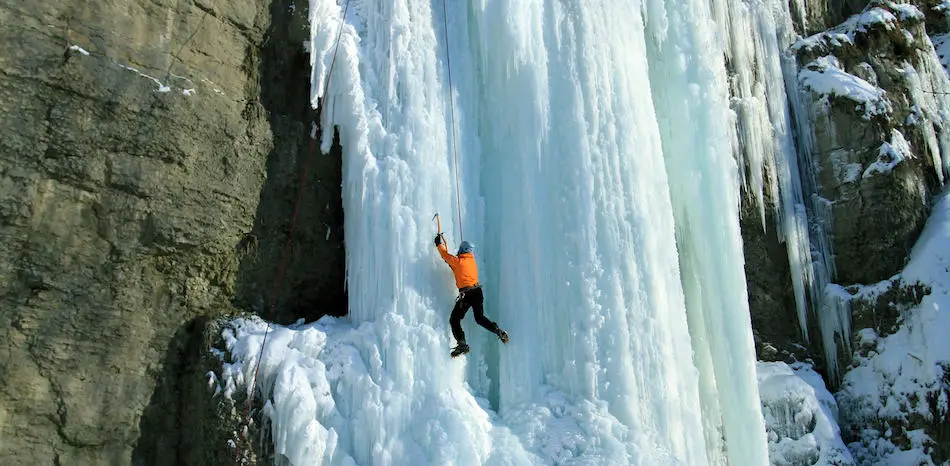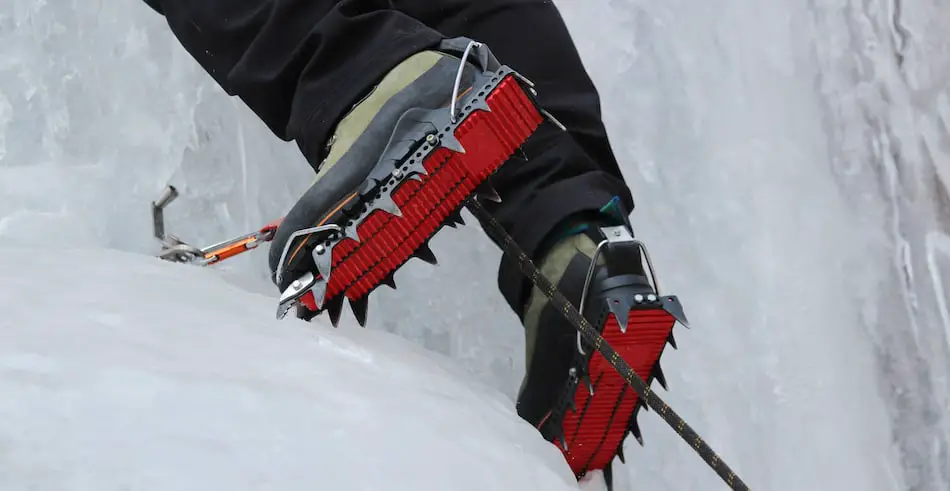
A couple seasons ago my friend and I were wondering if it was possible to climb ice in ski boots. I did a little research and created the following guide to answer that question.
So, can you ice climb in ski boots? Yes, it is possible to ice climb in ski boots, although it will be more difficult than with mountaineering boots. Ski boots or alpine touring boots will function perfectly fine for ice climbing, as long as you bring the right equipment.
Because of their rigid soles, ski boots give you the support you need to ice climb in them. As long as you get the proper crampons, such as a pair of Lowe Foot Fangs, you will find that the stiff plastic of the ski boot allows you to gain purchase on ice. However, you should be aware of the fact that your boots will be a lot heavier than mountaineering boots, which might make it more difficult to climb on the ice.
Ice Climbing in Ski Boots
So, as I said above, ice climbing in ski boots in entirely possible. In fact, American legend Charlie Fowler did most of his ice climbing in ski boots, which is a testament both to his skill and to the fact that even challenging routes can be climbed while wearing ski boots.
Now, while it is possible to do, I would in no way recommend that someone who’s just getting into ice climbing goes out and buys a pair of ski boots specifically for vertical ice. While it’s possible to climb in them, they’re not as good as mountaineering boots are for technical ice, so you shouldn’t purchase a pair of ski boots solely for ice climbing.
Most people who ice climb in ski boots do it for one of two reasons:
- They don’t want to carry extra gear: On a long ski-touring approach or an alpine route, hauling along an extra pair of boots with you can be a major pain. Using your ski boots on ice saves you both pack weight and the trouble of having to change your boots while waist-deep in snow.
- They’re just getting into the sport and already own ski boots: I would wager a bet that more people own skiing boots than they do ice climbing boots. If you just want to go for a casual crag day with your buddies, or you want to try out the sport without needing to buy a bunch of new equipment, ice climbing boots will serve their intended purpose.
For those who are used to ice climbing in mountaineering boots, ski boots or alpine touring boots might feel different and strange, and it can be harder to perform some of the more technical moves with them on. For sheets of ice or climbs in the WI-3 to WI-5 range (depending on your experience, of course), however, ski boots should work fine.
Pros

Although they won’t be as good all-around as ice climbing boots will be, there can be some advantages to wearing your ski boots:
- Fewer Pieces of Equipment: As I said above, this is one of the main benefits to wearing your ski boots ice climbing. If you’re ski mountaineering or just have a long approach and you want to go cross-country, being able to bring one pair of boots saves time and weight. Additionally, changing your boots in frigid alpine weather sucks, and you don’t have to do that if you can simply strap your crampons on to the ski boots.
- Cheaper: If you already have ski boots, you don’t need to go out and buy a $600 piece of footwear before you can start climbing. Additionally, you don’t have to worry about struggling with sizing, finding the right boots, and then breaking them in just so you can go ice climbing, because you already own the boot.
- Easier to penetrate the ice: Anyone who’s worn them before knows that ski boots are heavy. When swinging with your kicks, this additional weight on your foot can really put some power behind the movement and make it easier for you to drive your crampon home. The weight can also be good at making your feet stick in the ice. All in all, wearing ice climbing boots can give you more solid foot placements.
- Increased warmth and comfort: Ice climbing boots are bulky and fairly formfitting. Because of how stiff the ankle is and how solidly your foot is held in place, you’re less likely to drive your toes into the front of the boot when kicking, which can save you a lot of bruising and pain. Additionally, the thick padding and plastic shell means that ice climbing boots will often be warmer than their mountaineering counterparts– a lifesaver on cold days.
Cons
Although there are some advantages to ice climbing in ski boots, there are also some drawbacks that you need to be aware of:
- Can be harder to find crampons: Not every pair of crampons on the market is going to fit over a pair of ice climbing boots, which can limit your options when shopping. This can be frustrating if you find a pair of crampons that fulfill all of your needs but simply aren’t compatible or don’t fit well with your ski boots.
- Harder to be precise with your footwork: This is the counterpoint to some of the benefits mentioned above. While ice climbing boots are indeed heavier, which allows you to kick harder and retain more warmth, you also lose a lot of the sensitivity in your foot. This can make it harder to find good placements, and harder to test how good a placement is. Thin ice that requires good footwork, or mixed routes with tiny holds, will be more difficult to climb accurately.
- Reduced flexibility: Similarly to the last point, ski boots are made out of a rigid shell that doesn’t allow for a whole lot of ankle flexibility. This makes it more difficult to do complex moves or different ice climbing methods; for example, you will find yourself unable to do any French-technique ice climbing on lower terrain.
- Easier to get fatigued: A pound on the foot is worth three on the back, the old saying goes. Ski boots are heavy, and having to move around in them all day can tire you out more quickly than mountaineering boots would.
- Harder on the approach: For people who want to use their ski boots in locations where they walk on the approach, they can become a massive inconvenience. Walking in them is annoying, slow, and clunky; you’ll likely need to bring a pair of approach boots for you to wear, which means you’ll have to change in and out of them. This is one of the reasons that I wouldn’t recommend having ski boots as your only option for ice climbing.
Most of the disadvantages related to wearing ski boots ice climbing is the fact that they make it more difficult. In a sport where falling is never okay and you need to do everything you can to prevent coming off the wall, adding an added layer of complexity might not be the best of ideas unless you’re absolutely confident in your abilities.
What Gear do you Need?

So, we now know some of the advantages and disadvantages to ice climbing in ski boots. With that down, let’s talk about some of the specific selections you want to make in terms of gear.
Boots
Not all ski boots are made the same. The consensus in the ice climbing community is that Alpine Touring boots (AT boots) make the best choice for hybrid skiing/ice climbing missions.
Alpine touring boots are a niche of ski boots that are made for back country endeavours. Unlike downhill ski boots, which are all rigid plastic and are only created with the descent in mind, AT boots have been designed to work for both ski touring and descending. This makes them more flexible, more natural to walk in, and less cumbersome than traditional ski boots.
This increased flexibility and decreased weight helps these boots to bridge the gap between ice climbing boots and ski boots, making them a good option for someone who’s looking for a pair.
When buying boots, the biggest thing you want to consider (as always) is comfort of fit. The best boot is the one that you can spend hours in at a time without any pinching, rubbing, or hot sports. Check out my guide here for more information about how to fit your boots properly.
Crampons
When shopping for crampons, the most important thing to consider is that you get ones that come with a metal toe bail.
A toe bail is the metal loop on the front of the crampon that swings over the toe of your boot and holds it in place. This helps keep the crampon snugly in position, allowing you to kick and step with confidence. For ski boots, you want to ensure that the crampon has a wide enough bail to vit over the front.
Because not every pair of crampons will be compatible with ski boots, it can be a good idea to bring them in to the store with you and try it out. If you’re in doubt, you can always ask a sales representative to help you find something that works.
If you find a pair of crampons that you like but that aren’t compatible, you can always try buying a metal toe bail (or just a wider one, if the one on your boot doesn’t fit — but make sure it’s still metal) and installing it yourself.
Conclusion
So, there we go! Ice climbing in ski boots is entirely possible and is fairly common within the community.
Please be aware that I am not a certified mountain guide and I am not trying to give any recommendations here. I retain no responsibility if you go ice climbing and hurt yourself (no matter what type of boot you’re wearing). This blog is simply meant to entertain and inform, and should not be the final word on any questions that you have. Do your own research and seek expert advice before making any decisions.
Thanks for reading!
